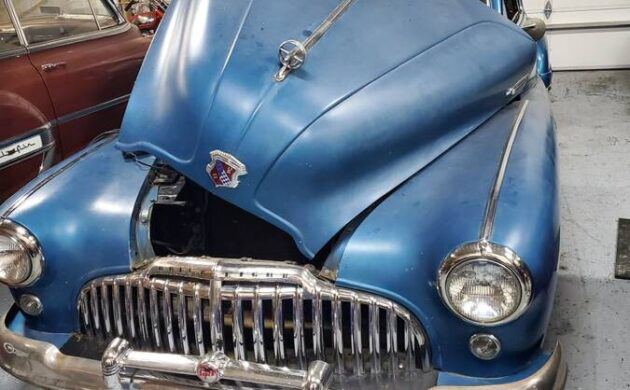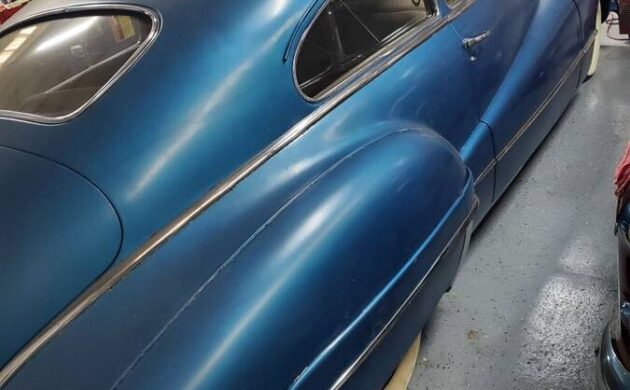Ready to Roll: 1946 Buick Super Sedanet
Buick’s well-selling Super line was introduced in 1940 and generally combined – with a few idiosyncratic exceptions throughout its production – the full-sized Roadmaster body with the economy engine of the Special. The first post-war restyle in 1946 brought front fender lines that swept all the way to the rear fenders, and new comforts in the cabin. Four body styles were offered: the four-door sedan (the bestseller), the estate wagon, a convertible, and the attractive two-door sedanet (series 56-S). Here on craigslist is a 1946 Buick Super sedanet, with an asking price of $14,000. This car is located in Stanwood, Washington, and it can be driven to its new garage. The seller is representing the car for a friend. Matt R. sent us this tip – thanks Matt!
The listing doesn’t quite attain the brevity of some I’ve seen, but it comes close. We’re told only that the car runs “smooth” and “everything works”, and that it has a “new front end.” I’m not sure what that means – suspension? steering? or even sheet metal? We do know its engine is the venerable OHV 248 Fireball straight eight paired with a Carter carburetor. The pre-war “compound carburetion” which simply meant dual carbs, had been discontinued, downrating the power output to about 110 hp. Prior to 1947, the crankshaft bearings were still the cast-in-place babbitt type; in 1947, inserts were used. The transmission is a column-shift, three-speed manual. Racing down the roadway at the Super’s top speed of 75 mph, gazing down that long hood through the gunsight ornament: this ’46 was “the best Buick yet”!
The interior benefits from new door panels. Other than the steering wheel which could use light restoration, the trim and major components are in great shape. The rear seats are near-perfect. An ash tray, clock, sunvisors, turn signals, and mirrors rounded out the accessories now included with the Super.
Aside from the ad’s brevity, there’s the matter of the photos. I wish sellers could make the time to move their vehicles into a driveway. Not a single one of these photos shows the entire car. This section of the rear hints at the fastback styling that made the sedanet so attractive. We also get a glimpse of the fender skirts, side trim, and wide white walls. The paint has lost its shine but who knows how it might look after a thorough detailing. In terms of value, cars from the 1940s are experiencing a slide. This car sold for over $40k, a realm usually reserved for the convertible, so I’m going to call that an anomaly. Hagerty indicates a value of $17,400 for an “excellent” example. What do you think it will take to find this car a new home?
Auctions Ending Soon
 2006 Ford Mustang Saleen S281 SCBid Now10 hours$15,000
2006 Ford Mustang Saleen S281 SCBid Now10 hours$15,000
 2002 Subaru Impreza WRXBid Now3 days$333
2002 Subaru Impreza WRXBid Now3 days$333
 1975 Chevrolet Corvette ConvertibleBid Now3 days$3,000
1975 Chevrolet Corvette ConvertibleBid Now3 days$3,000
 1964 Ford F-100 Camper CustomBid Now3 days$2,000
1964 Ford F-100 Camper CustomBid Now3 days$2,000
 2006 Jeep Wrangler SportBid Now5 days$10,500
2006 Jeep Wrangler SportBid Now5 days$10,500





Comments
Grandfather’s Buick
I wish I knew how Hagerty figures market value. If you go by current auction 14k is just about right. 40k is way over the top. These 40s early 50s somewhat classics are great values. But to keep them drivable in these modern times a nightmare. Buick in the day was the average man’s car. The nine to fiver with a wife, kids and a dog. Nothing special. Today, you say Roadmaster and the world of classic car collectors go crazy. Its still a Buick no matter what anyone says. jv – smash palace
No, Chevrolet held that position. Buick was only one step below Cadillac.
No way was Buick an average Joe’s means of transport as Buick was only one down from Cadillac and a lot of Caddy owners “down graded” to Buick because they figured that it was a better car!
Be still my beating heart! What a beauty, from the massive in-your-face chrome grillwork flowing back to the swoop of the tail looking for all the world like it’s going 100mph standing still. And the room inside! You don’t need a radio, you could have a brass band playing from the back seat. Hang your desert water bag on the front, strap your swamp coolers to the outside front windows and go explore what’s left of the 2 lane highways. This car tells the world you have arrived in style.
An icon of a lost era in American motoring at an very reasonable price.
Nice car for what you’ll get but the price seems to hold it back. Face it
folks, the younger generation just isn’t
interested in cars like this one at all
and the ask for this one is a bit too
steep for an average retiree to buy
without herniating their bank account.
And if memory serves me, Buicks only became every man cars when they started showing up on used car
in the ’50s. Only bankers, judges, and
solid business people could afford to
buy these new as they were one step
below that years Cadillac. And if you
bought one used, you were the talk of
your neighborhood and most everyone came out to see your new-
to-you Buick. And they walked away
saying “I’ll have a car like that some
day.”. They may have been slow as
slugs, but they ferried you and yours
around in style– especially when you
went to church on Sundays. How do I
know? I went to a small church where
the petitioners were lower middle class and bought cars like this one
to impress other petitioners who went there. Me, I did light mechanical
work for them on Saturday mornings
while the ladies cleaned the church.
I’d do tune-ups, change their oil, anti
freeze, thermostats and the like. If
they needed brake work, I’d send ’em
down to a guy I knew who’d do it on
the cheap and do it right. Had a good
side hustle going too. $10 got you a
tune up, $5 got your oil changed, and
$15 got your car ready for winter with
a radiator flush, a new thermostat, and a fresh fill of antifreeze that would protect your car to -84 degrees
below zero. Those were my labor rates per job and the owner bought
their own parts.to make the repairs.
But I’ve digressed long enough. Looks like the finish will shine up if
you’re careful and buff it out by hand.
Everything else looks great too. Good deal for someone though.
Three of us bought a ‘47 Super 4 door for $100 at Aloha motors on Oahu. This was 1961. Had it 3 years and sold it for $100. Thing ate retread tires. Ran great.
Irritates me when folks won’t go to the trouble of backing cars out of the garage for pics. I feel better having got that off my chest. Lol
Amen!
Can’t help but wonder…
I remember growing up with braces on my teeth as a kid. Never understood the reference until I saw one of these in person. I went home and smiled in the mirror – sure enough, looked like the front end of a ’47 Buick! Beautiful car. Wish I had the room….
It has always raised a red flag with me when I see a battery charger hooked up to the car . Is the battery bad, or does it have a charging issue? Maybe it’s just me. But I love the car. A lot!
Another car from my childhood days, and I love it!!
I need a big garage like Jay Leno (and his money)…. LOL
Hi Michelle. Nice write up on a nice car. Is there a reporting protocol, or accuracy checker with regards to what a car actually sells for on any particular site? Forty grand for the Bring A Trailer Buick seems like an anomaly for sure.
Perhaps fella only copped Twenty G’s but has two more stowed away. Has he established a “value” artificially?
I had a 49 Super sedanette. Straight 8 with dynaflow transmission. It had knee action hydraulic shocks. Top speed was 110, took a while to get there though. Grandparents bought it new in Nashville from Cumberland Motors if my memory serves me well. Still had 6 volt system. Would start every time if you didn’t let it sit a long period of time. To start it you turned the key on and floored the gas pedal to hit the starter button. Drove it in high school with a fox tail tied to the antenna located just above the center of the windshield. This was in 1973.
“To start it you turned the key on and floored the gas pedal to hit the starter button.”
I don’t know how many times I have heard or read this, but it isn’t true. The switch was on the side of the carburetor.
To start a cold Buick straight eight from this era, with the key in the OFF or LOCK position, you push the accelerator pedal to the floor one time and release. This sets the automatic choke. Turn the key to the ON position and press the gas pedal down just enough for the engine to crank over. The gas pedal linkage allows the starter switch to make contact and then the engine cranks.
If the engine is hot, turn the key to ON and push the pedal to the floor. This opens the choke and the engine starts.
My first car was a 1952 Buick Super 4D with DynaFlow. Yes, it took awhile for it to get up to speed, but back in the ’70s, I could drive it at 70 MPH all day long.
Back in the Twenties I also drove my ’51 Super at 70 mph all day long. As for the starter, the plastic actuator on the carburettor disintegrated so I had to install a button. I also fitted it with an 8v battery and never had a problem starting the car and it didn’t blow any of the gauges, lights etc.
Gil, thanks for the info. Didn’t know that. Just knew how to start it.
I always though the Buick Super was built on a Special body with a Roadmaster engine, and the four ports of a Roadmaster.
The pre war Buick Century used a Special body, equipped with a Roadmaster (320 c.i. engine).
Super and Roadmasters shared bodies, except that the RM had a longer hood, due to the longer engine.
The Century late through 1942. It re-appeared in 1954 and had three portholes. The ’55 Century had four portholes, as did the Roadmaster and the Super. Only the ’55 Special had three portholes.
Should have said “The Century lasted through 1942.”
My 1951 Super also had three portholes.
My 49 Super had only 3 port holes
Three portholes was correct for Supers and later Specials (not the ’49 Special).